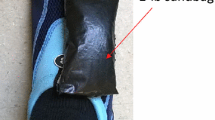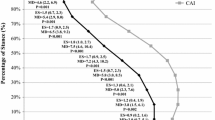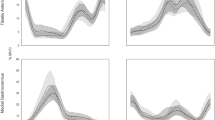Abstract
Dynamic response characteristics of ankle musculature following sudden ankle inversion have traditionally been tested in a static, standing position. However, this model does not take into consideration muscle activity and loading characteristics associated with active gait. This study compared muscle reaction times and amplitudes from sudden ankle inversion during standing (standing group) and walking (walking group) using one of two similar devices for each of these conditions. Surface EMG was collected from the peroneus longus (PL), brevis (PB), and tibialis anterior (TA) of the dominant leg from 25 subjects (age 20 ± 1 years, height 174.0 ± 10.2 cm, mass 74.3 ± 12.9 kg) for each condition (walking and standing). Time to total inversion ROM (28°) was greater in the walking group (114.9 ± 15.0 ms) than the standing group (65.6 ± 17.8 ms, P < 0.05), whereas reaction time was less in the peroneals in the walking group (PL 56.9 ± 8.4 ms, PB 60.1 ± 10.6 ms, TA 65.0 ± 14.9 ms) compared to the standing group (PL 74.3 ± 8.5 ms, PB 73.5 ± 8.2 ms, TA 73.3 ± 8.3, P < 0.05). Additionally, Peak normalized EMG (% MVIC) for the walking condition (PL 367 ± 254, PB 405 ± 359, TA 84 ± 39) exceeded that of the standing condition (PL 310 ± 239, PB 328 ± 215, TA 76 ± 39, P < 0.05), and average normalized EMG (% MVIC) was greater in the peroneals for the walking condition (PL 233 ± 171, PB 280 ± 255) than the standing condition (PL 164 ± 131, PB 193 ± 137, P < 0.05). The differences noted between the conditions provide evidence that a dynamic response to ankle injury mechanisms is much different in a walking model compared to a traditional standing model. A walking model may be a more functional approach for evaluating dynamic response characteristics of ankle musculature due to sudden ankle inversion.






Similar content being viewed by others
References
Christensen LO, Petersen N, Anderson JB, Sinkjaer T, Nielsen JB (2000) Evidence for transcortical reflex pathways in the lower limb of man. Prog Neurobiol 62:251–272
Ebig M, Lephart SM, Burdett RG, Miller MC, Pincivero DM (1997) The effect of sudden inversion stress on EMG activityof the peroneal and tibialis anterior muscles in the chronically unstable ankle. J Orthop Sports Phys Ther 26:73–77
Isakov E, Mizrahi J, Solzi P, Susak Z, Lotem M (1986) Response of the peroneal muscles to sudden inversion of the ankle during standing. Int J Sport Biomech 2:100–109
Johansson H, Sjolander P, Sojka P (1991) Receptors in the knee joint ligaments and their role in the biomechanics of the joint. Biomed Eng 18:341–368
Konradsen L, Ravn JB (1990) Ankle instability caused by prolonged peroneal reaction time. Acta Orthop Scand 61:388–390
Konradsen L, Ravn JB (1991) Prolonged peroneal reaction time in ankle instability. Int J Sports Med 12:290–292
Konradsen L, Ravn JB, Sorensen AI (1993) Proprioception at the ankle: the effect of anaesthetic blockade of ligament receptors. J Bone Joint Surg Br 75:433–436
Konradsen L, Voigt M, Hojsgaard C (1997) Ankle inversion injuries. The role of the dynamic defense mechanism. Am J Sports Med 25:54–58
Latash M (1998) Neurophysiological basis of movement. Human Kinetics, Champaign, p 267
Lynch SA, Eklund U, Gottlieb D, Renstrom AFH, Beynnon B (1996) Electromyographic latency changes in the ankle musculature during inversion moments. Am J Sports Med 24:362–369
McLoda TA, Hansen AJ, Birrer DA (2004) EMG analysis of peroneal and tibialis anterior muscle activity prior to foot contact during functional activities. Electromyogr Clin Neurophysiol 44:223–227
Mora I, Sylvie Q, Chantal P (2003) Electromechanical assessment of ankle stability. Eur J Appl Physiol 88:558–564
Myers JB, Riemann BL, Hwang J, Fu FH, Lephart SM (2003) Effects of peripheral afferent alteration of lateral ankle ligaments on dynamic stability. Am J Sports Med 31:498–506
Nakazawa K, Kawashima N, Akai M, Yano H (2004) On the reflex coactivation of ankle flexor and extensor muscles induced by a sudden drop of support surface during walking in humans. J Appl Physiol 96:604–611
Nawoczenski DA, Owen MG, Ecker ML, Altman B, Epler M (1985) Objective evaluation of peroneal response to sudden inversion stress. J Orthop Sports Phys Ther 7:107–109
Nieuwenhuijzen PHJA, Gruneberg C, Duysens J (2002) Mechanically induced ankle inversion during human walking and jumping. J Neurosci Methods 117:133–140
Osborne MD, Chou L, Laskowski ER, Smith J, Kaufman KR (2001) The effect of ankle disk training on muscle reaction time in subjects with a history of ankle sprains. Am J Sports Med 29:627–632
Pederson TS, Ricard MD, Merrill G, Schulthies SS, Allsen PE (1997) The effects of spatting and ankle taping on inversion before and after exercise. J Athl Train 32:29–33
Sinkjaer T, Anderson JB, Ladouceur M, Christensen LO, Nielsen JB (2000) Major role for sensory feedback in soleus EMG activity in the stance phase of walking in man. J Physiol 523:817–827
Vaes P, Duquet W, Van Gheluwe B (2002) Peroneal reaction times and eversion motor response in healthy and unstable ankles. J Athl Train 37:475–480
Author information
Authors and Affiliations
Corresponding author
Rights and permissions
About this article
Cite this article
Ty Hopkins, J., McLoda, T. & McCaw, S. Muscle activation following sudden ankle inversion during standing and walking. Eur J Appl Physiol 99, 371–378 (2007). https://doi.org/10.1007/s00421-006-0356-9
Accepted:
Published:
Issue Date:
DOI: https://doi.org/10.1007/s00421-006-0356-9




